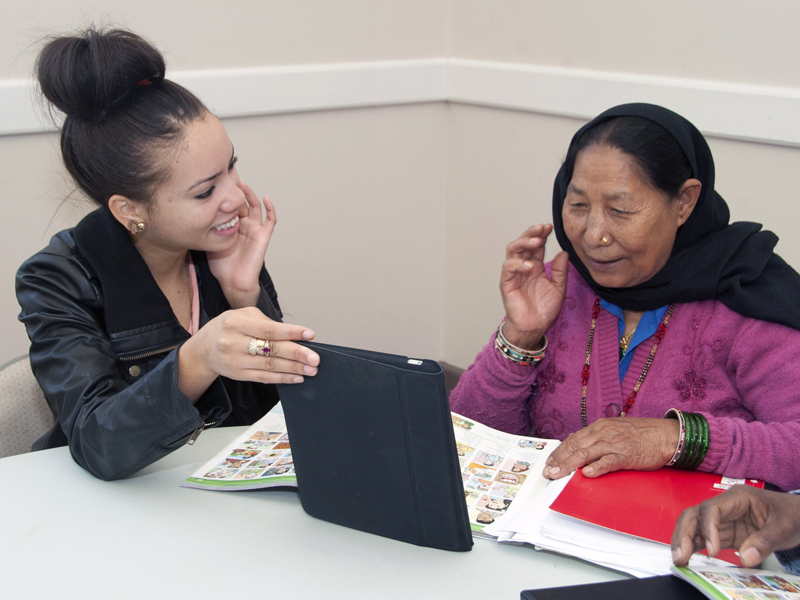
Student Gema Roja, pictured instructing Bhagirathi Monger, is a member of a Georgia Perimeter ESL class that tutors immigrants. (photo by Bill Roa)
Project SHINE celebrating its 10th anniversary at college
Gema Roja, a Georgia Perimeter College student from Cuba, opened her iPad and showed Bhagirathi Monger a photo.
The elderly Bhutanese woman smiled and then pointed to her elbow. “That’s right, elbow,” said Roja, who then flipped to another screen on the iPad to show a photo of a young girl brushing her hair. Monger then carefully wrote the words “elbow” and “hair” in her workbook.
At first glance, the young woman and older student would seem an unlikely pair: The Spanish-speaking Roja is still learning the particulars of the English language, while the elderly Monger struggles with basic reading and writing skills.
Yet both women are part of successful program called Project SHINE, an acronym for Students Helping in Naturalization and English. Monger attends classes at Clarkston Community Center, where GPC students, including Roja, from Debra Denzer’s English as a Second Language class come once a week to teach.
“This is definitely a stereotype-breaking program,” says Denzer. The connection between young, non-native speakers and elderly immigrants has been an effective way to strengthen English skills of both parties, she adds.
“A lot of my students find they have gaps in their own [English] learning, and working with the students at the Clarkston center really helps them. And there really is a connection—it’s like they are working with their grandparents.”
This is the 10th year for the Project SHINE partnership pairing Georgia Perimeter's ESL students with the Clarkston Community Center's elderly immigrants. Denzer launched the GPC program in 2004; Dunwoody ESL instructor Beth Wallace also led GPC's Project SHINE involvement for several years.
The Project Shine program originated at Temple University in 1985.
This year, Georgia Perimeter's ESL class received iPads, thanks to an instructional technology grant. While Denzer’s students love the functionality of the computer, the technology also has helped the older immigrants, who ordinarily rely on picture books for their lessons.
“We can make the fonts and pictures bigger,” says Denzer. “This is good for these elderly students, whose vision is sometimes not so great.”
Denzer's ESL students write their reflections about their experiences after visiting the center.
“My experience at Clarkston Community Center has helped me to understand how hard it is for a person from another country to learn a new language with a new alphabet,” wrote one student. “For people like me whose first language is French, it is not very hard for us to learn American English because we have the same alphabet and we have taken English classes since middle school. But for people whose first language is Nepali or Japanese, it is a little bit difficult for them to learn a new language, especially if they are a little bit old.”
Sheila Bowser, an instructor at the Clarkston Community Center, concurs. “The GPC students are extremely helpful in reinforcing our students’ skills—and they look forward to their visits,” she says.
“Teaching the elderly immigrants makes these students note how lucky they are to be getting an English education as a young person,” says Denzer.
